Deferasirox for the Treatment of Chronic Iron Overload in Transfusional Hemosiderosis
This report describes the Food and Drug Administration's review of data and analyses leading to the approval of the oral iron chelator, deferasirox for the treatment of chronic iron overload due to transfusional hemosiderosis.
Purpose: This report describes the Food and Drug Administration's review of data and analyses leading to the approval of the oral iron chelator, deferasirox for the treatment of chronic iron overload due to transfusional hemosiderosis.
Experimental Design: The FDA reviewed findings of a controlled, open-label, randomized multicenter phase III study of deferasirox vs deferoxamine in 586 patients with beta-thalessemia and transfusional hemosiderosis. The study results as well as the results of the FDA review of chemistry, preclinical pharmacology, and supportive studies are described.
Results: Following 48 weeks of treatment in the phase III study, patients' liver iron concentrations (a key endpoint variable) had decreased an average of 2.4 mg of iron (Fe)/g dry weight (dw) and 2.9 mg Fe/g dw in the deferasirox and deferoxamine groups, respectively, despite continued blood transfusions in both cohorts. Deferasirox was associated with serum creatinine increases in approximately a third of patients. Common adverse events included gastrointestinal symptoms and skin rash. Other data provided supportive evidence of deferasirox safety and efficacy.
Conclusions: The FDA granted deferasirox accelerated approval on November 2, 2005, for use in treating chronic iron overload due to transfusional hemosiderosis in patients ≥ 2 years of age. The sponsor must obtain clinical data demonstrating the drug's long-term safety and effectiveness.
Red blood cell transfusion therapy administered on a long-term, recurrent basis is a mainstay in the treatment of several chronic congenital and acquired anemias.[1-3] However, patients receiving such transfusions may consequently develop transfusional hemosiderosis, a major complication of iron overload that sometimes results in heart failure, cirrhosis, diabetes mellitus, or other endocrinopathies.[4-6]
Lessening the body's iron burden through chelation therapy with the parenteral agent deferoxamine has been shown to prevent or delay the complications of transfusional hemosiderosis.[1,2] However, the pharmacologic features of deferoxamine require its prolonged infusion, usually for 8 to 12 hours at least 5 days a week. This inconvenience and infectious complications associated with the route of administration limit compliance with the deferoxamine regimen, and patients may consequently develop progressive manifestations of transfusional hemosiderosis.[7,8]
Deferasirox (Exjade) was developed for use as an orally administered therapeutic iron chelation agent.[9,10] Its safety and efficacy were demonstrated in 48-week controlled clinical trials (with some patients entering extension studies of up to 3 years duration). This review summarizes the major clinical and supportive data and the regulatory process leading to the US Food and Drug Administration's (FDA's) approval of deferasirox for use in the treatment of chronic iron overload resulting from transfusional hemosiderosis in patients ≥ 2 years of age.[11]
Regulatory Background
Prior to the approval of deferasirox, the only drug approved by the FDA for the treatment of transfusional hemosiderosis was deferoxamine.[12,13] Because deferoxamine must be administered parenterally over 8 to 12 hours, the FDA regarded an oral alternative to deferoxamine as an important, unmet medical need. The original deferasirox investigational drug application was submitted on June 30, 1999, and deferasirox received FDA Fast Track status on February 21, 2003. The Fast Track program facilitates development and expedites review of new drugs for serious or life-threatening conditions not otherwise being addressed. Additionally, because of the relative rarity of transfusional hemosiderosis, the FDA designated deferasirox an Orphan Drug (a product that treats a disease affecting fewer than 200,000 Americans). On November 2, 2005, deferasirox received accelerated approval; this approval category requires the sponsor to demonstrate the drug's long-term safety and efficacy.[11]
Iron Metabolism and Chelation Therapy
The process of iron metabolism in the human body (including the limitations on iron excretion) has been well described.[4,5] In a state of metabolic balance, the human body absorbs 1 to 2 mg of iron daily from the diet and loses a similar amount through cellular sloughing. Iron administration in excess of this amount results in sequestration within the body, where it accumulates in end organs and can result in toxicity and organ damage. Since transfusional therapy may require administration of 2 to 3 units of red blood cells per month (each unit containing 200-250 mg of iron [Fe]), patients may present evidence of transfusional hemosiderosis within a few years of monthly transfusions.[14]
Methods to monitor iron stores in patients undergoing long-term transfusion therapy are limited in utility and meaningfulness. Serum ferritin measurement is convenient but correlates incompletely with the body's iron stores.[4] Measurement of iron concentration in a liver tissue biopsy sample is thought to more accurately reflect total body iron stores. Normally, iron concentration in the liver is < 1.5 mg Fe/g dry weight (dw). In patients with hemosiderosis, liver iron concentration (LIC) usually exceeds 2 mg Fe/g dw and may reach ≥ 55 mg Fe/g dw. A patient's cumulative blood transfusion history has been shown to correlate with LIC.[1,4]
A correlation between LIC and the risk of cirrhosis and cardiac damage has not been established.[6,15] However, exploration of the clinical utility of LIC has been especially limited by the invasive nature of liver biopsy. This limitation has prompted the development of noninvasive methods to measure LIC. Assessment techniques such as magnetic resonance imaging and magnetic field detection procedures using a superconducting quantum interference device (SQUID) were partially explored in the deferasirox clinical development program.
Chemistry
Deferasirox is the active component of Exjade tablets for oral suspension. Designated chemically as 4-[3,5-Bis (2-hydroxyphenyl)-1H-1,2,4-triazol-1-yl]-benzoic acid, this agent is a white to slightly yellow powder with a molecular formula of C21H15N3O4 and a molecular weight of 373.4. The structural formula of deferasirox is shown in Figure 1.
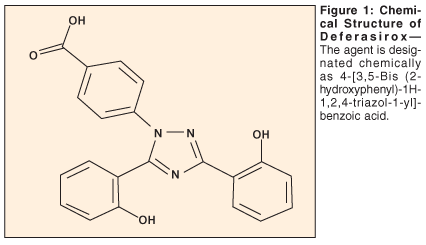
The drug product is a tablet in three strengths: 125, 250, and 500 mg. Doses should be calculated so that whole tablets will be used (rounded to the nearest whole tablet). Tablets are not swallowed directly but are dispersed in 3.5 oz of liquid for doses < 1 g or in 7.0 oz of liquid for doses > 1 g. Patients should drink the resulting suspension. The suspension should be used immediately after preparation.
Pharmacology and Toxicology
Deferasirox is a member of the tridentate iron chelator class of drugs. Two molecules of deferasirox bind one ferric atom.
Absorption, Distribution, Metabolism, and Excretion
Deferasirox was rapidly absorbed following single oral doses in mice, rats, dogs, marmosets, monkeys, and humans. The drug and its iron complex were extensively bound (> 98%) to plasma proteins in all species tested, including man. Whole-body autoradiography tissue distribution studies in rats showed the highest levels of radioactivity in the gastrointestinal tract and excretory organs (liver, kidneys, and intestine). Regardless of the route of administration, deferasirox was excreted predominantly via bile/feces in all tested species. Renal excretion of deferasirox and its metabolites was approximately 8% of the administered dose.
Toxicology
The major target organ of deferasirox toxicity in all tested animal species was the kidney; toxicity in other target organs (eye, heart, gastrointestinal tract) varied according to species. Deferasirox was not tumorigenic in rats and transgenic mice.
Human Experience
In humans, peak deferasirox plasma levels were achieved 1 to 4 hours after oral administration. The mean maximum blood concentration (Cmax) and area under the concentration-time curve (AUC) values of deferasirox and its iron complex increased in a dose-related manner within a dose range of 2.5 to 80 mg/kg. Deferasirox steady-state was achieved after 3 days of daily dosing. The drug's terminal half-life ranged from 8 to 16 hours following oral administration. In vitro metabolism studies in human liver microsomes and human hepatocytes have shown deferasirox to be primarily metabolized by glucuronidation, with an acyl-glucuronide being the major metabolite.
Clinical Studies
The clinical development of deferasirox was based on results of preclinical studies documenting the drug's iron chelation bioactivity and on results of early-phase clinical studies that showed pharmacokinetics and iron chelation pharmacodynamics sufficient to justify oral, once-daily dose administration.[10]
Phase I and II Studies: Overview
Exploratory studies examined deferasirox pharmacokinetics and bioactivity in healthy volunteers and patients over a period of ≤ 2 weeks. Longer exposure times were examined in four phase II clinical studies that explored a range of deferasirox dosages in patients who had a broad variety of anemias associated with transfusional hemosiderosis.
Two phase II studies compared various deferasirox doses to deferoxamine. One of these studies randomized 71 adult patients with beta-thalessemia and transfusion dependence to one of three treatment cohorts: 10 mg/kg/d or 20 mg/kg/d deferasirox or 40 mg/kg deferoxamine injected subcutaneously 5 consecutive days each week. The findings from this 48-week study suggested that a deferasirox dose of 20 mg/kg/d decreased LIC to the same approximate degree as the deferoxamine regimen did, whereas 10 mg/kg/d deferasirox maintained LIC at a stable value. As a result, in most subsequent clinical studies, including the confirmatory study, baseline LIC was the determining factor in selection of a deferasirox dose regimen.
The other comparative phase II study randomized 195 adult and pediatric patients with sickle cell disease and transfusional iron overload to one of several deferasirox dosages (dose range: 5-30 mg/kg daily) or to deferoxamine at 20-60 mg/kg. Preliminary safety data from 6 months of dosing (submitted in the marketing application) were similar to those for patients with other types of anemia.
Two noncomparative phase II studies were performed to obtain deferasirox safety and bioactivity data for specific populations. These populations and underlying conditions consisted of the following: pediatric patients with beta-thalassemia previously treated with deferoxamine (n = 40), other beta-thalessemia patients (n = 85), myelodysplastic syndrome patients (n = 47), Diamond Blackfan syndrome patients (n = 30), and patients with a variety of rare anemias such as aplastic, sideroblastic, autoimmune hemolytic, and Fanconi's anemias, alpha-thalassemia, myelofibrosis, pure red cell aplasia, and pyruvate kinase deficiency (n = 22). Overall, changes in LIC and serum ferritin were similar to the confirmatory study's findings.
These phase I and II studies provided important safety and bioactivity assessments for patients with a variety of anemic conditions. The findings suggested that deferasirox's activity (lowering of LIC) and safety profiles were similar regardless of a patient's underlying condition.
Phase III Confirmatory Clinical Study
• Patients and Methods-A single phase III clinical study (Study 0107) provided the definitive evidence of deferasirox safety and efficacy.[12] This multicenter, multinational study, initiated in 2003, enrolled subjects from 12 countries, including the United States. The majority (68%) of subjects were from Greece, Italy, Turkey, and Tunisia.
Eligible subjects were adult and pediatric patients with transfusional hemosiderosis who could have received prior treatment with deferoxamine. Patients with abnormal serum creatinine levels or serologic evidence of human immunodeficiency viral infection were excluded. Multiple other exclusion criteria limited enrollment to patients who were likely to comply with drug and study protocols.
The study was a randomized, open-label study in which deferasirox was compared to deferoxamine in patients ≥ 2 years old with beta-thalassemia and transfusional hemosiderosis. Patients had baseline assessments of LIC by biopsy or SQUID, with the assessment repeated (using the same methodology) at the end of the 1-year treatment period. Other major evaluations during the study-some limited to study population subgroups-were assessments of serum ferritin, growth velocity, clinical laboratory values, iron balance measurements, ocular and auditory examinations, and echocardiography.
The dosages of deferasirox and deferoxamine were protocol-specified based on certain criteria (Table 1). Deferasirox dosages were determined by patients' baseline LICs, which were stratified by value, with each value range assigned a dosage level in an attempt to tailor the deferasirox dose according to the baseline need for chelation therapy. Deferoxamine assigned dosages were also tailored (by protocol-specified categorization) to the perceived need for chelation. However, certain patients who had previously received deferoxamine were allowed to continue the prior dosage regardless of baseline LIC. Deferoxamine was subcutaneously infused via an automated pump over ≥ 8 hours for 5 consecutive days each week.

Dose adjustments were permitted for both study agents based on safety findings and evidence of over or underchelation. Blood transfusion therapy was to continue throughout the study to maintain blood hemoglobin concentrations ≥ 9.0 g/dL.
The study's primary endpoint was a comparison of "success" between the two study groups according to the protocol-specified definition of success (Table 2), an outcome based on the change in LIC from baseline to end of study. The protocol specified that deferasirox would be considered noninferior to deferoxamine if the two-sided 95% confidence interval (CI) of the difference in success rates between the two study groups was above 15%.
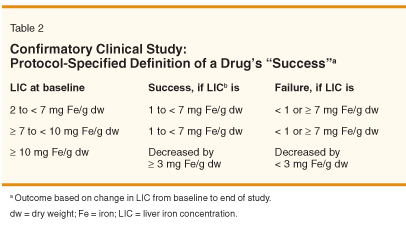
The primary endpoint variable, LIC, was assessed at baseline by liver biopsy in most patients. Some pediatric patients had LIC determined noninvasively using SQUID methodology, an investigational technique with limited performance characterization. Liver biopsy samples were analyzed at a single center using well-accepted methodologies. SQUID determinations were conducted at three centers (Turin, Italy; Hamburg, Germany; Oakland, USA). For each patient, LIC was reassessed after 1 year using the same methodology used at baseline.
The key secondary efficacy endpoint outcomes were a comparison between the cohorts of the change from baseline in LIC among patients whose baseline LICs were ≥ 7 mg Fe/g dw and a comparison within the deferasirox cohort of LICs at baseline and 1 year later.
In interpreting the study findings, FDA reviewers noted that limited data supported the selection of the primary endpoint's noninferiority margin. Consequently, the FDA focused on analyses of the change in LIC from baseline among subjects receiving deferasirox. A clinically meaningful change (decrement) from baseline was considered substantial evidence of efficacy in light of the continuing blood transfusion therapy administered during the treatment period.
• Results: Randomization and Compliance-Overall, 591 beta-thalessemia patients were randomized (1:1) to receive either deferasirox (n = 297) or deferoxamine (n = 294). Before initiation of treatment, one patient in the deferasirox group and four in the deferoxamine group withdrew consent and were not treated. Patients' baseline characteristics are shown in Table 3. The treatment groups were generally balanced with respect to important baseline and demographic characteristics.
Table 4 summarizes the protocol-assigned doses of the study drugs and the average doses actually administered to enrolled subjects. In general, the average deferasirox doses administered were consistent with the assigned doses, whereas the administered deferoxamine doses in patients with LIC < 7 mg Fe/g dw were somewhat higher than the assigned doses because the protocol allowed patients previously treated with deferoxamine to receive prestudy dose levels.
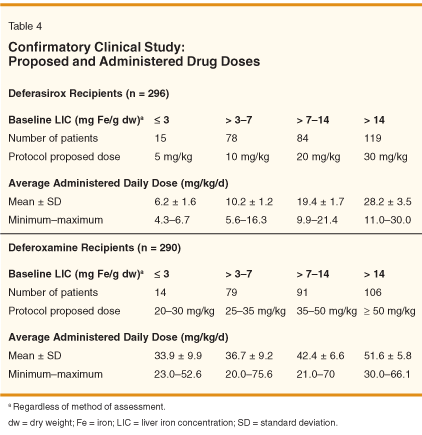
The frequency and characteristics of dosing interruptions were similar for the two cohorts. However, dose adjustments owing to adverse events or laboratory abnormalities were twice as common in the deferasirox group as in the deferoxamine group, mostly because of protocol-mandated changes in response to elevations in serum creatinine values.
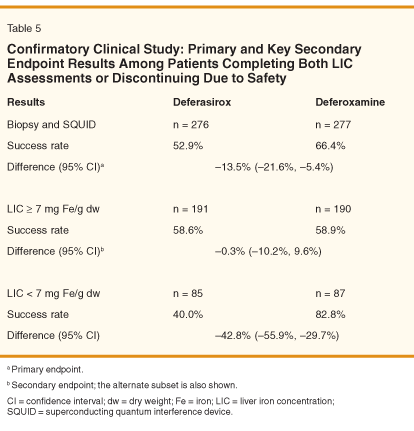
• Results: Efficacy-The primary analysis (comparison of success rates between the two cohorts) did not meet the prespecified boundary for noninferiority (Table 5). Post hoc subset analyses as well as the secondary endpoint results suggested that deferasirox's failure to achieve the prespecified noninferiority margin was related predominantly to the maintenance of relatively high, prestudy deferoxamine doses and to the disproportionately low dosing of deferasirox (5 and 10 mg/kg/d) compared with deferoxamine.[12] In a prespecified subset analysis that excluded patients receiving the two lowest deferasirox and deferoxamine dosages (ie, patients with baseline LIC ≥ 7 mg Fe/g dw; n = 381), the difference in success rates between the cohorts was -0.3 (95% CI = -10.2, 9.6), a finding that would have fulfilled the primary endpoint goal of demonstrating deferasirox's noninferiority.
Other secondary endpoints included assessments of changes in serum ferritin concentration and changes in iron balance (Table 6 and Figure 2). Dose-dependent effects on serum ferritin concentrations over time that generally paralleled the changes in LIC were observed in both deferasirox- and deferoxamine-treated patients.

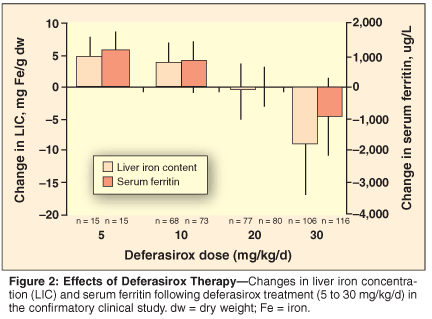
Iron balance is assessed as the calculated ratio of iron excretion to iron intake. Negative iron balance (corresponding to an iron excretion:iron intake ratio > 1) indicates removal of iron in excess of that received from transfusion. In this confirmatory study, the ratios of iron excretion to iron intake in the overall population across all LIC values were similar for deferasirox- and deferoxamine-treated patients. Importantly, the iron excretion:iron intake ratio was observed to be closely dose related in deferasirox-treated patients (ratio < 1 at doses of 5 and 10 mg/kg/d, ≈1 at 20 mg/kg/d, and > 1 at 30 mg/kg/d).
• Results: Safety-Approximately 33% of deferasirox-treated patients had an increase in serum creatinine, although those increases frequently remained within normal limits. Dose reduction or interruption of deferasirox administration was usually associated with a fall in serum creatinine to the baseline value. The changes in renal function were not progressive despite resumption or continuation of deferasirox at lower dosages.
Deferasirox administration was also associated with an increase in the urinary protein:urinary creatinine ratio in a minority of patients. In 17 deferasirox-treated patients, serum liver enzyme concentrations (serum glutamic pyruvic transaminase/alanine aminotransferase) increased to more than five times the upper limit of normal on two consecutive assessments, whereas five deferoxamine-treated patients experienced these abnormalities. Two patients had liver biopsy-confirmed drug-induced hepatitis, and both discontinued deferasirox. Increases in liver enzyme concentrations did not appear to be dose-related.
Integrated Safety Results From All Clinical Studies
Overall, 700 adult and pediatric patients (including those with beta-thalassemia [n = 469], sickle cell disease [n = 132], and various rare anemias [n = 99]) were administered deferasirox in clinical studies lasting at least 48 weeks. The most frequently occurring adverse events in these patients were diarrhea, vomiting, nausea, headache, abdominal pain, pyrexia, cough, and increase in serum creatinine. In general, rates of gastrointestinal symptoms, increases in serum creatinine, and skin rash suggested a deferasirox dose relationship. With the exception of increases in serum creatinine, the pattern of adverse events was similar for patients receiving deferasirox and those receiving deferoxamine (Table 7).

Adverse events leading to discontinuation of deferasirox, as well as serious adverse events assessed as drug-related, occurred in 3% of the 700 deferasirox-treated patients. The most common events prompting deferasirox discontinuation were gastrointestinal disorders, skin rash, increase in liver enzymes/drug-induced hepatitis, renal abnormalities, cataract development, and hyperactivity. Serious adverse events were skin rashes, gastrointestinal disorders, and increases in serum liver enzyme concentrations.
Among 700 deferasirox-treated patients, 6 deaths were recorded. In the beta-thalassemia population, one unexplained sudden death occurred in a 3-year-old child who had complicating risks and who received 31 mg/kg/d deferasirox for 84 days. Five patients with other chronic anemias died-three with sepsis in the setting of neutropenia that was present at baseline or developed in association with the use of chemotherapeutic drugs, one with recurrent thromboembolism, and one with cardiopulmonary arrest and known cardiac disease.
Discussion
Clinical studies demonstrated that orally administered deferasirox could decrease LIC in a dose-related manner and provided definitive evidence of this agent's efficacy and safety over a 1-year period.
In the confirmatory clinical study, the dose assignment procedures and primary endpoint (a comparison between the two cohorts of "success" in reducing LIC) presented unique challenges in data interpretation. The challenges generally related to two study design limitations: a dosage-tailoring paradigm limited to one study (the deferoxamine group) and the lack of a clinically verifiable basis for estimation of the noninferiority margin incorporated into the study's primary endpoint definition.[16,17] The FDA review of the confirmatory study's findings required consideration of these inherent limitations in study design. Hence, FDA considered the totality of the clinical data, rather than focusing solely upon the somewhat arbitrarily defined primary endpoint.
The standard for FDA approval is demonstration of safety and efficacy. There is no legal requirement for comparative safety and efficacy; ie, a new drug neither has to be more safe and effective nor "noninferior" in safety and efficacy than existing therapies-in this case, deferoxamine. The decrease in LIC baseline to end of study among deferasirox-treated patients became the primary evidence of effectiveness, and the totality of preclinical and clinical data showed that deferasirox administration decreased markers of iron overload in a dose-related manner over a 1-year period.
The data were reviewed at the September 29, 2005, meeting of the FDA Blood Products Advisory Committee. A critical discussion at that meeting concerned the "clinical meaningfulness" of a decrease in LIC, the main measure for assessing drug efficacy in the confirmatory and supportive clinical studies. Advisory Committee members uniformly acknowledged that a reduction in LIC was acceptable as a major determinant of treatment effect. While acknowledging some controversy surrounding the correlation of LIC with iron content within the heart, committee members generally supported the contention that deferasirox-induced alterations in LIC provided a clinically meaningful indication of the drug's therapeutic benefit.
An important limitation of this assessment is that the benefit was observed only over a short (1-year) period (the confirmatory study's duration), during which time important safety concerns were demonstrated. Some of these, such as deterioration in renal function, were strongly predicted by preclinical tests. Others, such as evidence of liver damage and gastrointestinal disturbance, were predicted to a lesser extent by animal testing but may correlate with deferasirox's known metabolic pathway.
On November 2, 2005, the FDA granted deferasirox accelerated approval for the treatment of chronic iron overload due to blood transfusions in patients ≥ 2 years of age. Full prescribing information is available at the FDA website.[18]
The accelerated approval pathway is generally pursued for drugs whose major treatment effects were determined based on alterations in surrogate endpoints (substitute endpoints likely to predict clinical benefit) rather than endpoints that show direct clinical benefit. In the case of deferasirox, however, the accelerated pathway was prompted by the need to obtain long-term data verifying the drug's safety and clinical benefits. The accelerated approval regulations allow this pathway in situations in which a study drug's major treatment effects were shown to affect a clinically meaningful endpoint (such as a change in LIC) but where additional clinical data are necessary to verify the drug's long-term benefit.[19]
Conclusions
Marketing approval of deferasirox presents a new option for Americans with transfusional hemosiderosis, especially patients intolerant of deferoxamine. Over a 1-year period, deferasirox was shown to effectively lower body iron stores with acceptable toxicity.[19] Management of this toxicity either through alterations or interruptions of deferasirox dose necessitates regular monitoring of patients' serum creatinine and liver enzyme values. Additionally, serum ferritin monitoring is recommended to detect evidence of under or overchelation.
Important questions remain regarding the use of chelation therapy, especially prophylactically in patients showing little or no evidence of iron overload. Since the available clinical data for deferasirox were obtained only from patients who had clear evidence of transfusional hemosiderosis at baseline, these data are insufficient to support the drug's prophylactic use in the absence of such manifestations. Additional questions remain regarding the possible coadministration of deferasirox with deferoxamine, an important consideration given the different pharmacokinetic and pharmcodynamic effects of the two drugs and the potential for additive benefit.[20] These and other important issues must be explored in subsequent clinical studies.
Disclosures:
The authors have no significant financial interest or other relationship with the manufacturers of any products or providers of any service mentioned in this article.
References:
1. Rund D, Rachmilewitz E: Beta-thalassemia. N Engl J Med 353:1135-46, 2005.
2. Brittenham G, Griffith P, Nienhuis A, et al: Efficacy of deferoxamine in preventing complications of iron overload in patients with thalassemia major. N Engl J Med 331:567-573, 1994.
3. Sazama K, DeChristopher P, Dodd R, et al: Practice parameter for the recognition, management, and prevention of adverse consequences of blood transfusion. Arch Pathol Lab Med 124:61-70, 2000.
4. Andrews N: Disorders of iron metabolism. N Engl J Med 341:1986-1995, 1999.
5. Angelucci E, Brittenham G, McLaren C, et al: Hepatic iron concentration and total body iron stores in thalassemia major. N Engl J Med 343:327-331, 2000.
6. Olivieri N, Brittenham G: Iron-chelating therapy and the treatment of thalassemia. Blood 1997;89:739-61.
7. Kwiatkowski J, Cohen A: Iron chelation therapy in sickle-cell disease and other transfusion-dependent anemias. Hematol Oncol Clin North Am 18:1355-1377, 2004.
8. Cohen A, Galanello R, Pennell D, et al: Thalassemia. Hematology Am Soc Hematol Educ Program 14-34, 2004.
9. Cunningham M, Nathan D: New developments in iron chelators. Curr Opin Hematol 12:129-134, 2005.
10. Cappellini M: Iron-chelating therapy with the new oral agent ICL670 (Exjade). Best Pract Res Clin Haematol 18:289-298, 2005.
11. US Food and Drug Administration: FDA approves first oral drug for chronic iron overload. Available at www.fda.gov/bbs/topics/news/2005/NEW01258.html. Accessed November 20, 2006.
12. Cappellini M, Cohen A, Piga A, et al: A phase 3 study of deferasirox (ICL670), a once-daily oral iron chelator, in patients with beta-thalassemia. Blood 107:3455-3462, 2006.
13. Roberts D, Rees D, Howard J,et al: Desferrioxamine mesylate for managing transfusional iron overload in people with transfusion-dependent thalassaemia. Cochrane Database Syst Rev (4):CD004450, 2005.
14. Cunningham M, Macklin E, Neufeld E, et al: Thalassemia Clinical Research Network. Complications of beta-thalassemia major in North America. Blood 104:34-39, 2004.
15. Berdoukas V, Dakin C, Freema A, et al: Lack of correlation between iron overload cardiac dysfunction and needle liver biopsy iron concentration. Haematologica 90:685-686, 2005.
16. Hung J, Wang S, Tsong Y, et al: Some fundamental issues with non-inferiority testing in active controlled trials. Stat Med 22:213-225, 2003.
17. Makuch R, Johnson M: Issues in planning and interpreting active control equivalence studies. J Clin Epidemiol 42:503-511, 1989.
18. US Food and Drug Administration: Exjade (deferasirox) prescribing information. Available at www.fda.gov/cder/foi/label/2005/021882lbl.pdf. Accessed November 20, 2006.
19. US Code of Federal Regulations: 21 CFR 314.510.
20. Kontoghiorghes G, Eracleous E, Economides C, et al: Advances in iron overload therapies, prospects for effective use of deferiprone (L1), deferoxamine, the new experimental chelators ICL670, GT56-252, L1NA11 and their combinations. Curr Med Chem 12:2663-2681, 2005.
Newsletter
Stay up to date on recent advances in the multidisciplinary approach to cancer.
Oncology Peer Review On-The-Go: Cancer-Related Fatigue Outcome Measures in Integrative Oncology
September 20th 2022Authors Dori Beeler, PhD; Shelley Wang, MD, MPH; and Viraj A. Master, MD, PhD, spoke with CancerNetwork® about a review article on cancer-related fatigue published in the journal ONCOLOGY®.